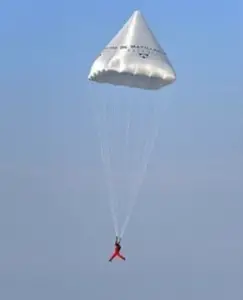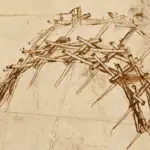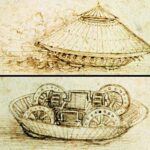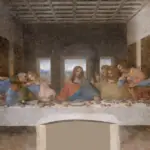Leonardo da Vinci Parachute is a fascinating invention from the Renaissance era that combines creativity with intricate design.
Da Vinci‘s parachute, designed in the 1480s, is remarkable because it aimed to prove that a human could safely descend from heights using a canopy of sealed linen cloth supported by wooden poles.
In the late 20th century, daredevil Adrian Nicholas tested da Vinci’s concept. Nicholas constructed the parachute following da Vinci’s original design specifications and boldly dipped from a hot-air balloon at 10,000 feet. The successful flight affirmed that da Vinci’s ideas, though centuries old, were revolutionary and feasible.
The invention reflects da Vinci’s forward-thinking approach to science and engineering, showcasing his desire to push the boundaries of human exploration. Leonardo da Vinci’s story continues to inspire engineers, scientists, and artists as it bridges the gap between art and science.
The Invention of the Leonardo da Vinci Parachute
Leonardo da Vinci parachute was a groundbreaking concept in the history of flight devices. This section explores the parachute invention’s historical origins, da Vinci’s time context, and the process behind his design.
Who Invented the Parachute?
The idea of the parachute can be traced back to Leonardo da Vinci, who sketched the initial concept in the late 15th century. His drawing depicted a pyramid-shaped device made from sealed linen cloth and wooden poles.
Although Leonardo da Vinci’s innovations in art and science were ahead of his time, Sebastien Lenormand wasn’t credited with the first practical parachute jump until the 18th century. While da Vinci’s parachute was not built or tested during his lifetime, it laid the groundwork for a critical advance in aviation. His idea remained theoretical until much later, illustrating his forward-thinking approach to invention.
The Historical Context of the Leonardo da Vinci Parachute
During the Renaissance, thinkers like Leonardo da Vinci explored new concepts in science and technology. The parachute was one of many visionary projects da Vinci worked on. His fascination with flight also led to the creation of the ornithopter, another innovative design intended to mimic bird flight.
The Renaissance era was a period of questioning and innovation, and da Vinci’s parachute reflects his curiosity about the laws of nature and movement. Although the technology of the time limited the feasibility of these inventions, his work laid the foundation for future innovations.
How Leonardo da Vinci’s Parachute Design Came to Be
Leonardo da Vinci’s parachute design was unique for its time. He proposed a pyramid-shaped canopy made of wood and linen that would slow a person’s descent from height.
His sketches show a meticulous attention to detail, blending his artistic skills with scientific inquiry. Although da Vinci never saw his ideas come to fruition, modern tests have validated the effectiveness of his design.
Recently, replicas of his parachute have been built and successfully tested, proving the concept he originated centuries ago. Da Vinci’s ability to conceptualize complex mechanics remains impressive, showcasing his unparalleled genius.
Understanding the Design of the Leonardo da Vinci Parachute
Leonardo da Vinci parachute was a remarkable concept demonstrating his forward-thinking approach in the Renaissance era. The design featured innovative elements, unique materials, and a distinctive shape that set it apart from modern parachutes.
Key Features of the Leonardo da Vinci Parachute Design
The Leonardo da Vinci parachute design included a pyramid shape that deviated from the circular canopy typical in today’s parachutes. It was intended to control descent with a frame attached to a square canopy.
Da Vinci believed this design could slow a person’s fall and allow for a safe landing. This innovation showcased his understanding of aerodynamics and physics.
Despite being conceptualized in the 15th century, the parachute has been discussed and tested to see if it would function as intended. This further underlines his advanced thinking and creativity during his time.
Materials Used in the Leonardo da Vinci Parachute
Leonardo’s parachute was designed using wood and canvas. The wooden frame provided structure and support to the canopy, while the canvas acted as the main surface that caught the air.
These materials were readily available during da Vinci’s time, making it possible to construct such devices without modern technology.
The emphasis was on creating a lightweight yet robust design. The choice of wood and canvas reflects da Vinci’s ability to utilize existing materials effectively in his inventions. This design paved the way for later advancements in parachute construction using similar principles.
The Pyramid Shape of the Leonardo da Vinci Parachute
One of the most intriguing aspects of the Leonardo da Vinci parachute was its pyramid shape. Unlike typical rounded parachutes, it featured a square base and an angular canopy. This shape was intended to control airflow and provide stability during descent.
The unique design demonstrated da Vinci’s foresight in solving potential challenges of freefall and landing. His drawings and concepts were remarkably ahead of their time, influencing later developments in parachute technology. This design was a testament to his ingenuity and an early exploration of flight and aerodynamics.
Testing the Leonardo da Vinci Parachute

The First test of Leonardo da Vinci Parachute
Leonardo da Vinci parachute was an innovative concept that eventually led to practical field tests. Modern skydivers like Adrian Nicholas dared to bring da Vinci’s designs into the real world, providing significant insights.
Did Leonardo da Vinci’s Parachute Work?
Leonardo da Vinci’s parachute design featured a pyramidal shape made from wood and canvas. The question of did Leonardo da Vinci’s parachute work captured enthusiasts and experts alike.
In 2000, British skydiver Adrian Nicholas undertook a bold experiment. He built a parachute based on Leonardo’s original drawings.
Nicholas successfully descended using the parachute from a height of 10,000 feet, proving Leonardo’s concept viable despite prior skepticism. This experiment demonstrated that even a 500-year-old design can be effective when constructed precisely, challenging the doubts of earlier experts who believed it would fail.
Modern Interpretations of the Leonardo da Vinci Parachute
Modern interpretations of Leonardo da Vinci’s parachute reflect a blend of admiration and curiosity. Skydivers and historians revisit da Vinci’s design to test its principles against contemporary standards.
Who invented the parachute has fascinated many, with da Vinci’s version representing a significant stepping stone.
Leonardo’s parachute is far from sleek, modern fabric chutes, yet enthusiasts appreciate the historical and technical insights such experiments provide.
Tests have inspired innovations in parachute design, blending the old with the new. They confirm the enduring appeal of Leonardo da Vinci’s inventions and showcase his genius in seeing beyond his time.
How to Make a Leonardo da Vinci Parachute: A DIY Guide
Creating a replica of Leonardo da Vinci’s parachute can be engaging. To start, you need to study Leonardo’s original parachute sketch.
The framework involves lightweight wood cut into a pyramidal shape. Cover the frame with sturdy fabric like canvas. Ensure the joints are secure to withstand air pressure. Follow the proportions closely to maintain stability and integrity.
This project allows enthusiasts to connect with history, offering insights into da Vinci’s inventive process. It serves as an accessible yet enlightening way to explore the fusion of art and science in Leonardo da Vinci’s inventions.
Closing Remarks
Leonardo da Vinci parachute design was a remarkable example of his inventive mind.
Conceived in the late 15th century, this design featured a pyramid-shaped canopy made from wood and cloth. Although the concept was theoretical during his time, modern experiments have proven that his design could indeed work.
Da Vinci’s creativity extended beyond the parachute. His sketches and notes included ideas for flying machines, which were well ahead of their time. These inventions showcased his deep interest in aerodynamics and the possibilities of human flight.
A key element of the parachute’s design was its simplicity. Unlike modern parachutes, da Vinci’s concept relied on basic materials and a straightforward structure. This simplicity made it a fascinating subject for enthusiasts who wish to recreate historical innovations.
The legacy of da Vinci’s parachute extends into today’s world, inspiring innovators and historians alike. His work is a testament to the enduring impact of visionary ideas.
Key Takeaways: Leonardo da Vinci’s parachute highlights his genius and forward-thinking nature. Even centuries later, his ideas continue to captivate and inspire. His work bridges the gap between art and science, paving the way for future technological advancements.
Frequently Asked Questions
Leonardo da Vinci, known for his inventive designs, created the concept of parachutes early on. While he did not test it himself, his designs have influenced various advancements in flight technology. His contributions raise interesting questions about his inventions and their impacts.
What did Leonardo da Vinci do with the parachute?
Leonardo da Vinci designed a parachute made of wood and canvas. Its unique triangular shape differed from modern circular parachutes. Though he did not build it, his sketches were detailed enough for others to construct later and test similar devices.
Who tested Leonardo da Vinci’s parachute?
The parachute was not tested during Leonardo’s lifetime. Much later, a skydiver named Adrian Nicholas tested da Vinci’s design in 2000 by leaping from a hot-air balloon, proving its viability and demonstrating its foresight.
Did Leonardo da Vinci invent skydiving?
Leonardo da Vinci did not invent skydiving, but his sketches contributed to the development of parachuting technology. Skydiving as a sport and recreation came much later, building upon initial concepts, including his, of controlled descent from great heights.
Who invented the parachute in 1483?
The parachute concept existed before Leonardo da Vinci’s time. However, his sketches from around 1485 are among the earliest detailed designs. Leonardo’s contribution played a significant role in the ongoing evolution of parachuting.
What did Leonardo da Vinci do to corpses?
Leonardo da Vinci studied human anatomy by dissecting corpses. This practice allowed him to create accurate drawings and enhance his understanding of human anatomy. These studies were crucial for his artistic and scientific endeavors.
How did Leonardo da Vinci’s parachute change the world?
Leonardo da Vinci’s parachute inspired future inventors and pioneers in flight. Though it was never built in his lifetime, the design exemplifies creative thinking in solving air travel and safety challenges.
What is the 33-barreled organ?
The “33-barreled organ” refers to one of Leonardo da Vinci’s designs for a multi-barreled cannon. This invention demonstrated his innovative approach to weaponry, featuring rows of small cannons that could be fired in succession.
Who invented the parachute jump?
Louis-Sébastien Lenormand is credited with making the first successful parachute jump in 1783. His actions marked a significant milestone in translating the idea of a parachute into a practical device.
What happened to Leonardo da Vinci when he was 15?
At 15, Leonardo da Vinci joined the artist Andrea del Verrocchio’s studio in Florence. This was a formative period in his life, during which he honed his skills in art and engineering.
Did Leonardo da Vinci make a hang glider?
Leonardo da Vinci designed machines inspired by bird flight. His sketches included a precursor to the hang glider. The device had wings for human flight, showcasing his fascination with flight mechanics.

 I’m Leonardo Bianchi, the mind behind Leonardo da Vinci's Inventions. Thanks for visiting.
I’m Leonardo Bianchi, the mind behind Leonardo da Vinci's Inventions. Thanks for visiting. 


